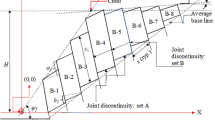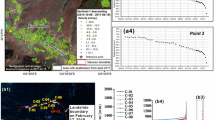Abstract
Discontinuity-controlled rock slope instability analysis is an important issue in slope engineering. In this study, an integrated approach based on probabilistic kinematic and block theory is proposed to calculate maximum safe slope angle (MSSA). It incorporates the varieties of discontinuity orientation, friction angle and block geometric shapes. It can provide a scientific MSSA value for rock slope engineering. The proposed integrated approach is applied to an important engineering slope. First, the probabilistic kinematic and block theory analyses are separately used to obtain MSSA. Then the mean value of the two calculations is taken as suggested MSSA of the slope, and suggested MSSA is 60.22°. The approach proposed in the paper integrates kinematic and block theory, and fully considers the variability of orientation and shear strength of discontinuity, and the approach is more objective. In addition, the persistence of discontinuities and the identification of in-situ blocks will be a valuable work in the future.







Similar content being viewed by others
Data availability
Most of the data generated during this study are included in this article, and other datasets generated during the current study are available from the corresponding author on reasonable request.
References
Azarafza M, Asghari-Kaljahi E, Akgün H (2017a) Assessment of discontinuous rock slope stability with block theory and numerical modeling: a case study for the South Pars Gas Complex, Assalouyeh, Iran. Environ Earth Sci 76:397. https://doi.org/10.1007/s12665-017-6711-9
Azarafza M, Asghari-Kaljahi E, Akgün H (2017b) Numerical modeling of discontinuous rock slopes utilizing the 3DDGM (three-dimensional discontinuity geometrical modeling) method. Bull Eng Geol Environ 76:989–1007. https://doi.org/10.1007/s10064-016-0879-1
Azarafza M, Akgün H, Feizi-Derakhshi M-R, Azarafza M, Rahnamarad J, Derakhshani R (2020a) Discontinuous rock slope stability analysis under blocky structural sliding by fuzzy key-block analysis method. Heliyon 6:e03907. https://doi.org/10.1016/j.heliyon.2020.e03907
Azarafza M, Akgün H, Ghazifard A, Asghari-Kaljahi E (2020b) Key-block based analytical stability method for discontinuous rock slope subjected to toppling failure. Comput Geotech 124:103620. https://doi.org/10.1016/j.compgeo.2020.103620
Azarafza M, Akgün H, Ghazifard A, Asghari-Kaljahi E, Rahnamarad J, Derakhshani R (2021a) Discontinuous rock slope stability analysis by limit equilibrium approaches - a review. Int J Digit Earth 14:1918–1941. https://doi.org/10.1080/17538947.2021.1988163
Azarafza M, Koçkar MK, Faramarzi L (2021b) Spacing and block volume estimation in discontinuous rock masses using image processing technique: a case study. Environ Earth Sci 80:471. https://doi.org/10.1007/s12665-021-09768-3
Chen JQ, Zhu HH, Li XJ (2016) Automatic extraction of discontinuity orientation from rock mass surface 3D point cloud. Comput Geosci 95:18–31. https://doi.org/10.1016/j.cageo.2016.06.015
Cruden DM (1978) A method of distinguishing between single and double plane sliding of tetrahedral wedges. Int J Rock Mech Min Sci Geomech Abstr 15:217–217
Goodman RE (1976) Methods of Geological Engineering in Discontinuous Rocks. West Publishing, San Francisco
Goodman RE (1989) Introduction to rock mechanics. Wiley, New York
Goodman RE, Shi GH (1985) Block theory and its application to rock engineering. Prentice Hall, New Jersey
Greif V, Vlčko J (2013) Key block theory application for rock slope stability analysis in the foundations of medieval castles in Slovakia. J Cul Herit 14:359–364
Gripp M (2003) The use of inclined hemisphere projections for analyzing failure mechanisms in discontinuous rocks. Eng Geol 67:321–330
Hocking G (1976) A method for distinguishing between single and double plane sliding of tetrahedral wedges. Int J Rock Mech Min Sci Geomech Abstr 13:A107
Hoek E, Bray JW (1981) Rock slope engineering, 3rd edn. CRC Press, Boca Raton
Huang TK, Chen JC, Chang CC (2003) Stability analysis of rock slopes using block theory. J Chin Inst Eng 26:353–359
Jia C, Li Y, Lian MY, Zhou XY (2017) Jointed surrounding rock mass stability analysis on an underground cavern in a hydropower station based on the extended key block theory. Energies 10:563
Kincal C (2014) Application of two new stereographic projection techniques to slope stability problems. Int J of Rock Mech Min Sci 66:136–150. https://doi.org/10.1016/j.ijrmms.2014.01.006
Kliche CA (1999) Rock Slope Stability SME, Littleton, CO
Kong DH, Wu FQ, Saroglou C (2020) Automatic identification and characterization of discontinuities in rock masses from 3D point clouds. Eng Geol. https://doi.org/10.1016/j.enggeo.2019.105442
Kong DH, Wu FQ, Saroglou C, Sha P, Li B (2021) In-situ block characterization of jointed rock exposures based on a 3D point cloud model. Remote Sens. https://doi.org/10.3390/rs13132540
Kottenstette J (1997) Block theory techniques used in arch dam foundation stability analysis. Int J Rock Mech Min Sci 34:163 (e161–163, e119)
Kulatilake P, Wang L, Tang H, Ye L (2011) Evaluation of rock slope stability for Yujian River dam site by kinematic and block theory analyses. Comput Geotech 38:846–860
Li CC, Zhang N, Ruiz J (2019) Measurement of the basic friction angle of planar rock discontinuities with three rock cores. Bull Eng Geol Env 78:847–856
Li YC, Chen JP, Zhou FJ, Zhou X, Li ZH, Wang Q (2023) Stochastic kinematic analysis of rock slope failure angle based on multi algorithm optimization, a case study of the proposed bridge project. Georisk. https://doi.org/10.1080/17499518.2023.2188466
Liu YQ, Chen JP, Tan C, Zhan JW, Song SY, Xu WL, Yan JH, Zhang YS, Zhao MY, Wang Q (2022) Intelligent scanning for optimal rock discontinuity sets considering multiple parameters based on manifold learning combined with UAV photogrammetry. Eng Geol. https://doi.org/10.1016/j.enggeo.2022.106851
Lucas JM (1980) A general stereographic method for determining the possible mode of failure of any tetrahedral rock wedge. Int J Rock Mech Min Sci Geomech Abstr 17:57–61
Matherson GD (1989) The collection and use of field discontinuity data in rock slope design. Eng Geol 22:19–30
Nilsen B (2000) New trends in rock slope stability analyses. Bull Eng Geol Environ 58:173–178
Obregon C, Mitri H (2019) Probabilistic approach for open pit bench slope stability analysis—a mine case study. Int J Min Sci Technol 29:629–640
Panet M, Vormeringer R, Vigier G, Goodman RE (1969) Discussion of “graphical stability analysis of slopes in jointed rock.” ASCE Soil Mech Found Div J 95:685–702
Park HJ, West TR, Woo I (2005) Probabilistic analysis of rock slope stability and random properties of discontinuity parameters, Interstate Highway 40, Western North Carolina, USA. Eng Geol 79:230–250
Park HJ, Lee JH, Kim KM, Um JG (2016) Assessment of rock slope stability using GIS-based probabilistic kinematic analysis. Eng Geol 203:56–69
Pathak S, Nilsen B (2004) Probabilistic rock slope stability analysis for Himalayan conditions. Bull Eng Geol Environ 63:25–32
Um JG, Kulatilake PH (2001) Kinematic and block theory analyses for shiplock slopes of the Three Gorges Dam Site in China. Geotech Geol Eng 19:21–42
Xu LM, Chen JP, Wang Q, Zhou FJ (2013) Fuzzy C-means cluster analysis based on mutative scale chaos optimization algorithm for the grouping of discontinuity sets. Rock Mech Rock Eng 46:189–198. https://doi.org/10.1007/s00603-012-0244-z
Yan J, Chen J, Li Y, Li Z, Zhang Y, Zhou X, Mehmood Q, Liu J, Wang Z (2021) Kinematic-based failure angle analysis for discontinuity-controlled rock slope instabilities: a case study of Ren Yi Peak Cluster in Fusong County, China. Nat Hazards 111:1–16
Yan J, Chen J, Zhou F, Zhang W, Zhang Y, Zhao M, Ji Y, Liu Y, Xu WL, Wang Q (2022) A new framework for geometrical investigation and stability analysis of high-position concealed dangerous rock blocks. Acta Geotech. https://doi.org/10.1007/s11440-022-01668-5
Yan J, Chen J, Tan C, Zhang Y, Liu Y, Zhao X, Wang Q (2023) Rockfall source areas identification at local scale by integrating discontinuity-based threshold slope angle and rockfall trajectory analyses. Eng Geol 313:106993. https://doi.org/10.1016/j.enggeo.2023.106993
Yoon WS, Jeong UJ, Kim JH (2002) Kinematic analysis for sliding failure of multi-faced rock slopes. Eng Geol 67:51–61
Zhao S (2015) Research on stability of bank slope of Chishui River Bridge. Southwest Jiaotong University (in Chinese)
Zheng J, Kulatilake PH, Shu B, Sherizadeh T, Deng J (2014) Probabilistic block theory analysis for a rock slope at an open pit mine in USA. Comput Geotech 61:254–265
Zheng J, Kulatilake P, Deng JH (2015) Development of a probabilistic block theory analysis procedure and its application to a rock slope at a hydropower station in China. Eng Geol 188:110–125
Zheng J, Kulatilake P, Deng JH, Wei JB (2016) Development of a probabilistic kinematic wedge sliding analysis procedure and application to a rock slope at a hydropower site in China. Bull Eng Geol Environ 75:1413–1428
Zheng J, Kulatilake P, Shu B (2017) Improved Probabilistic Kinematic Analysis Procedure Based on Finite Size Discontinuities and Its Application to a Rock Slope at Open Pit Mine in US. Int J Geomech 17:04016052.04016051-04016052.04016015
Zhou X, Chen JP, Chen Y, Song SY, Shi MY, Zhan JW (2017) Bayesian-based probabilistic kinematic analysis of discontinuity-controlled rock slope instabilities. Bull Eng Geol Environ 76:1249–1262. https://doi.org/10.1007/s10064-016-0972-5
Zhu H, Azarafza M, Akgün H (2022) Deep learning-based key-block classification framework for discontinuous rock slopes. J Rock Mech Geotech Eng 14:1131–1139. https://doi.org/10.1016/j.jrmge.2022.06.007
Acknowledgements
This work was supported by the National Natural Science Foundation of China (Grant nos. 41941017, U1702241).
Funding
This work was supported by the National Natural Science Foundation of China (Grant No.41941017, U1702241).
Author information
Authors and Affiliations
Contributions
All authors contributed to the study conception and design. Material preparation, data collection and analysis were performed by JX, CC, CT, JY, YJ and JC. The first draft of the manuscript was written by JX and all authors commented on previous versions of the manuscript. All authors read and approved the final manuscript.
Corresponding author
Ethics declarations
Conflict of interest
The authors declare that they have no known competing financial interests or personal relationships that could have appeared to influence the work reported in this paper.
Additional information
Publisher's Note
Springer Nature remains neutral with regard to jurisdictional claims in published maps and institutional affiliations.
Rights and permissions
Springer Nature or its licensor (e.g. a society or other partner) holds exclusive rights to this article under a publishing agreement with the author(s) or other rightsholder(s); author self-archiving of the accepted manuscript version of this article is solely governed by the terms of such publishing agreement and applicable law.
About this article
Cite this article
Xue, J., Cao, C., Tan, C. et al. An integrated maximum safe slope angle analysis approach based on probabilistic kinematic and block theory for discontinuity-controlled rock slope instabilities: a transportation corridor case. Environ Earth Sci 82, 604 (2023). https://doi.org/10.1007/s12665-023-11278-3
Received:
Accepted:
Published:
DOI: https://doi.org/10.1007/s12665-023-11278-3




